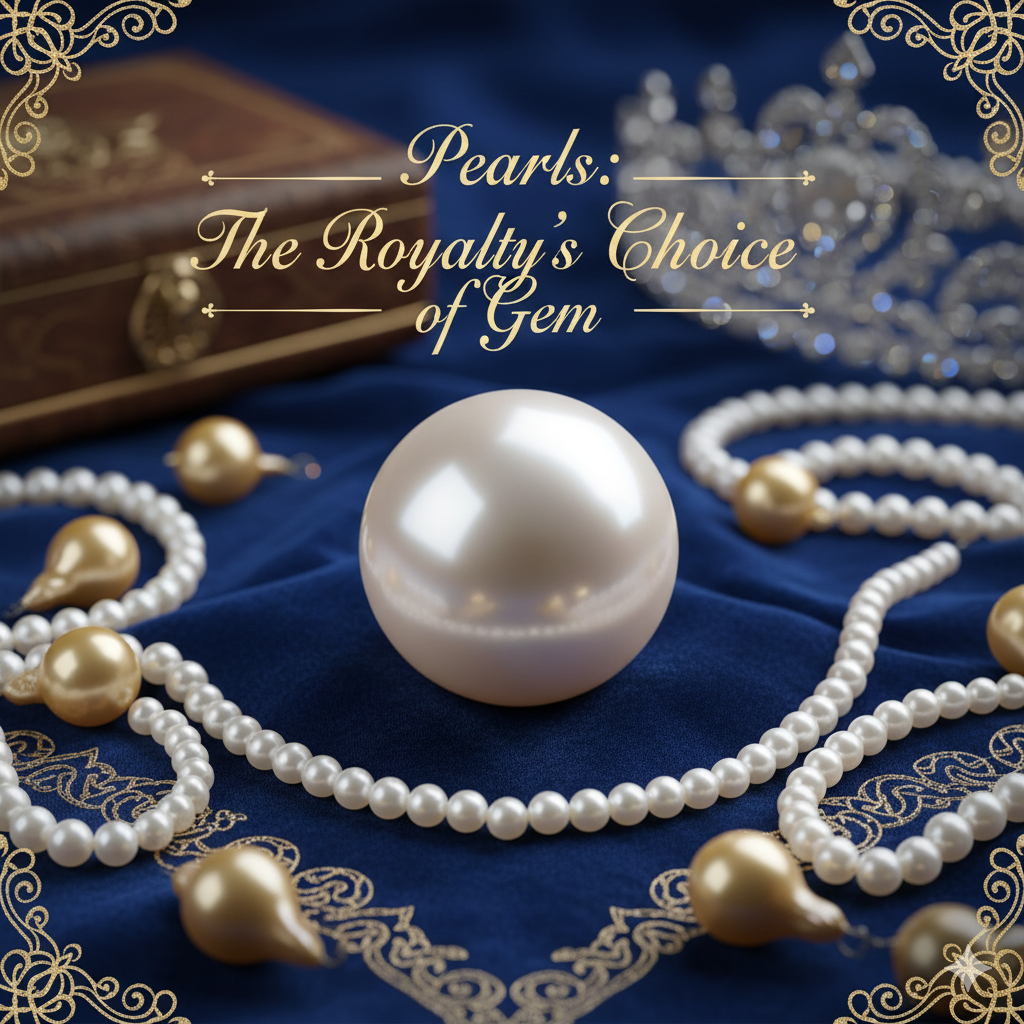Pearls: The Royalty’s Choice of Gem
From imperial courts to modern icons — the language of power written in light.
1) The Gem That Spoke Without Sound
Long before diamonds ruled engagement rings or emeralds crowned tiaras, it was the pearl that defined royalty.
Its glow carried no glare, its worth needed no declaration.
Among kings and queens, pearls became not adornments but a vocabulary of dignity — softness worn with authority.
Unlike faceted stones that shout brilliance, pearls whisper serenity.
They embody a paradox: fragile, yet eternal; humble, yet sovereign.
From Marie Antoinette to Queen Elizabeth II, from Princess Diana to Maharani Gayatri Devi, every generation of royalty has turned to pearls to mirror the virtues they wished the world to see — grace, restraint, and inner radiance.
2) The Crown’s Oldest Jewel
In the ancient world, pearls were symbols of divine favour.
Chinese emperors wore them as badges of wisdom.
Roman generals crushed them into wine to display wealth.
Persian monarchs called them “the solidified tears of angels.”
By the Renaissance, pearls had become Europe’s most coveted treasure — rarer than rubies, costlier than gold.
Kings gifted them to queens not merely as jewels but as alliances, tokens of peace and continuity.
No gem travelled further or held more stories — from Persian gulf divers to Indian maharajas, from Spanish galleons to English coronations.
3) Marie Antoinette — The Empress of Elegance
At Versailles, the 18th century’s brightest flame, Marie Antoinette, turned pearls into a political statement.
Portraits by Élisabeth Vigée Le Brun show her bathed in candlelight, her neck encircled by multi-stranded natural pearls that seemed to glow from within.
To her, pearls were virtue translated into fashion — uncut, untouched, impossibly pure.
They softened the grandeur of her gowns, balancing luxury with innocence.
After her fall, those same pearls outlived empires.
One strand — the famed Marie Antoinette natural pearl necklace — resurfaced centuries later at a Sotheby’s auction, fetching over $30 million, proof that light born of patience endures longer than power.
4) La Peregrina — The Pilgrim Pearl
If one pearl could tell every chapter of royal desire, it would be La Peregrina — “The Pilgrim.”
Discovered in the 16th century off the coast of Panama, it passed through the hands of King Philip II of Spain, Mary I of England, and the Bonaparte family of France before finding its modern guardian in Elizabeth Taylor.
La Peregrina was drop-shaped perfection — nearly 56 carats of natural nacre — a pearl so luminous it was mistaken for the moon.
It survived shipwrecks, revolutions, and heartbreaks, proving that beauty anchored in simplicity survives every storm.
Taylor once said, “I feel naked without pearls.”
Royal or not, that sentiment transcends time.
5) Queen Elizabeth II — The Discipline of Light
No monarch understood pearls quite like Queen Elizabeth II.
Through seventy years of reign, she made them her daily armor — three-strand Akoyas, worn with almost every ensemble.
Her choice was deliberate:
- Three strands represented continuity — past, present, future.
- White pearls symbolized purity of duty and thought.
- Akoya origin embodied precision and quiet perfection — values of the monarchy itself.
When photographed beside diamonds and tiaras, it was always the pearls that defined her silhouette — elegant, ageless, and resolutely unchanging.
Her jewelry vault held treasures from every empire, but pearls were the only ones she wore for herself.
6) Princess Diana — The Modern Heirloom
If Elizabeth represented stability, Princess Diana embodied emotional truth — and pearls became her language of transformation.
Her early portraits show soft, demure chokers — symbols of youthful grace.
By the 1990s, those same pearls evolved into statement pieces — multi-strand collars paired with bold off-shoulder gowns, reimagining tradition with confidence.
Most famous was her seven-strand pearl choker with the Sapphire and Diamond clasp, worn at the 1994 Serpentine Gallery dinner — the night tabloids called the “revenge dress.”
Diana understood what centuries of queens had known: pearls speak louder when the world expects silence.
7) Maharani Gayatri Devi — The Indian Pearl of Poise
Across continents, in the palaces of Jaipur, pearls took on another form — heritage.
Maharani Gayatri Devi, celebrated for her intellect and impossible beauty, made pearls part of her signature grace.
She wore them not as royal display but as personal calm.
Whether in chiffon saris or Paris couture, her triple-strand Basra necklaces and pearl-drop earrings glowed with an ease that transcended geography.
In photographs, her pearls never glitter — they breathe.
She represented an Eastern royalty that understood pearls as symbols not of rule, but of refinement.
Her contemporaries said:
“She could make silence look like silk.”
And that, in essence, is what pearls do.
8) The Nizam of Hyderabad — The Ocean’s Collector
No monarch amassed pearls like the Nizam of Hyderabad.
By the early 20th century, his vaults contained thousands of natural Gulf pearls, including ropes so long they brushed the floor.
Traders from Bahrain and Basra knew the Nizam’s court as the ultimate destination for perfect orbs of nacre.
His legendary collection included the seven-strand Basra necklace, pearl-tipped turban ornaments, and pearl-woven belts commissioned for state processions.
When Queen Elizabeth II married Prince Philip in 1947, the Nizam presented her with a Cartier diamond and pearl suite, now one of the crown’s most sentimental treasures.
For the Nizam, pearls were not mere wealth — they were a religion of light, worn as offerings to both God and grandeur.
8A) The Maharaja of Patiala — Grandeur in White and Gold
If Versailles symbolized indulgence and Buckingham restraint, Patiala represented magnificence itself.
In the early 20th century, Maharaja Bhupinder Singh of Patiala — ruler of one of India’s most powerful princely states — transformed jewelry into diplomacy.
No ruler combined aesthetic daring with royal command quite like him.
His vaults overflowed with Basra pearls, Golconda diamonds, Colombian emeralds, and Burmese rubies — yet pearls remained his visual signature.
The Patiala Necklace — A Nation’s Crown
Commissioned in 1928 from Cartier, the legendary Patiala Necklace remains one of the largest and most spectacular pieces of jewelry ever created.
It originally featured 2,930 diamonds and seven massive Basra pearls, anchored by the 234.69-carat De Beers yellow diamond at its heart.
The design itself blended Indian royal scale with European precision — a harmony of cultures that mirrored Patiala’s place between heritage and modernity.
When the Maharaja appeared wearing it, journalists compared him to a walking sun.
But beyond its spectacle, those pearls — large, natural, perfectly luminous — symbolized India’s mastery over subtlety within extravagance.
Pearls in the Patiala Court
In the Patiala household, pearls were worn by both men and women — not merely as ornaments but as emblems of grace.
The Maharani’s Basra strands were layered in threes and fives, while the Maharaja paired his pearl ropes with turban aigrettes and diamond buttons.
The combination of white pearls on gold turbans became synonymous with Punjab’s royal confidence — disciplined splendor born of lineage, not vanity.
The Vanishing and Return
After India’s independence, much of Patiala’s regalia disappeared.
The famous necklace resurfaced decades later, partly dismantled, at a Geneva auction in 1982.
Cartier painstakingly restored it using synthetic replacements for the missing stones — a resurrection of history through craftsmanship.
Today, the Patiala Necklace stands as a testament to how light, once captured, never fully fades.
9) The Global Language of Nobility
From Versailles to Buckingham, from Jaipur to Riyadh, pearls transcended culture and creed.
They appealed to monarchs because they embodied everything power must aspire to — calm, balance, humility, permanence.
A diamond is admired; a pearl is respected.
In every court portrait, pearls soften authority — turning rulers into reflections of grace.
And unlike other gems, pearls don’t need cutting.
They arrive complete — nature’s perfect metaphor for born nobility.
10) How Royal Pearls Differed
| Royal Figure | Pearl Type | Symbolism | Defining Quality |
|---|---|---|---|
| Marie Antoinette | Natural saltwater | Purity, divine right | Soft rose hue |
| Queen Elizabeth II | Akoya cultured | Duty, discipline | Mirror luster |
| Princess Diana | Akoya / South Sea | Emotional resilience | Multi-strand couture |
| Maharani Gayatri Devi | Basra natural | Serenity, intellect | Warm ivory tone |
| Nizam of Hyderabad | Basra natural | Wealth, piety | Abundance & rarity |
Each expressed power differently, but the thread connecting them all was restraint — the confidence to shine softly.
11) The Legacy in Modern Design
Today, designers reinterpret these royal motifs:
- Multi-strand chokers inspired by Diana.
- Soft single strands echoing Elizabeth’s signature.
- Baroque pendants reminiscent of Mughal treasures.
High houses like Mikimoto, Cartier, and Buccellati, as well as Indian heritage jewelers, continue to revive this lineage — proving that pearls remain the most wearable crown.
Even contemporary icons — from Kate Middleton to Queen Rania — use pearls not for nostalgia, but as continuity.
12) The Emotion Behind Royal Pearls
Pearls are emotional mirrors.
They carry warmth from skin, memory from touch, and subtle color shifts with time.
For centuries, queens have passed them down as inheritances of emotion, not just objects of adornment.
A diamond’s value is geological; a pearl’s value is human.
It lives, breathes, and remembers — glowing brighter the more it is worn.
That is why, for royalty, pearls were not jewelry; they were companions of identity.
13) PreciousCarats Perspective — Royal, Yet Human
At PreciousCarats, we see pearls not as unattainable regalia, but as the democratization of grace.
The same light that once adorned palaces now rests in palms — pure, calm, unhurried.
Whether it’s a single Basra drop or an Akoya strand, the emotion remains identical:
a meeting point of humility and majesty.
Royalty was never about crowns — it was about composure.
And pearls, more than any gem, have always known how to wear silence with authority.

